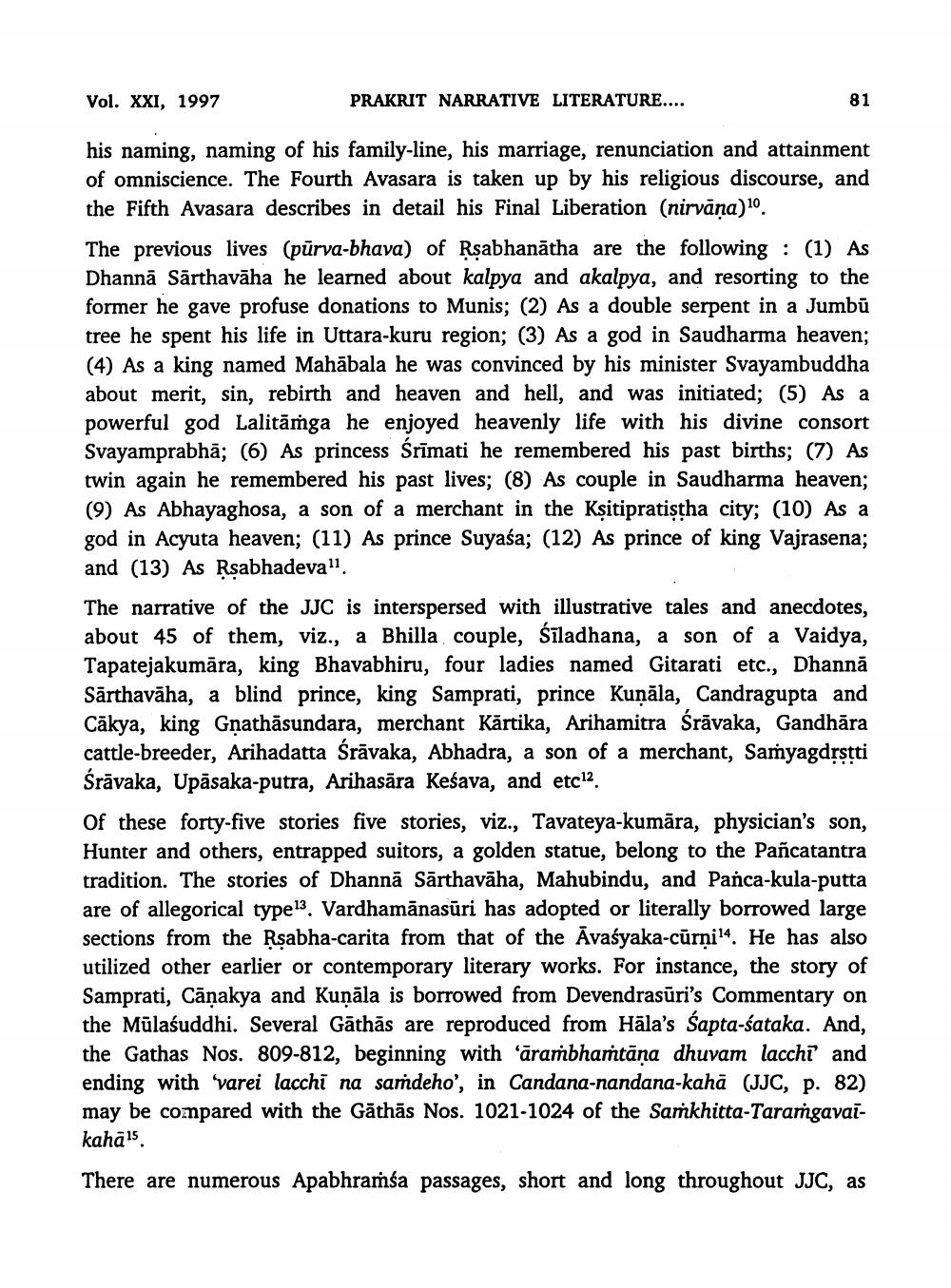________________
Vol. XXI, 1997
PRAKRIT NARRATIVE LITERATURE....
his naming, naming of his family-line, his marriage, renunciation and attainment of omniscience. The Fourth Avasara is taken up by his religious discourse, and the Fifth Avasara describes in detail his Final Liberation (nirvāna) 10.
The previous lives (pūrva-bhava) of Rsabhanātha are the following: (1) As Dhannā Sārthavāha he learned about kalpya and akalpya, and resorting to the former he gave profuse donations to Munis; (2) As a double serpent in a Jumbū tree he spent his life in Uttara-kuru region; (3) As a god in Saudharma heaven; (4) As a king named Mahābala he was convinced by his minister Svayambuddha about merit, sin, rebirth and heaven and hell, and was initiated; (5) As a powerful god Lalitāmga he enjoyed heavenly life with his divine consort Svayamprabhā; (6) As princess śrīmati he remembered his past births; (7) As twin again he remembered his past lives; (8) As couple in Saudharma heaven; (9) As Abhayaghosa, a son of a merchant in the Kșitipratistha city; (10) As a god in Acyuta heaven; (11) As prince Suyasa; (12) As prince of king Vajrasena; and (13) As Rsabhadeva" The narrative of the JJC is interspersed with illustrative tales and anecdotes, about 45 of them, viz., a Bhilla couple, Sīladhana, a son of a Vaidya, Tapatejakumāra, king Bhavabhiru, four ladies named Gitarati etc., Dhannā Sārthavāha, a blind prince, king Samprati, prince Kuņāla, Candragupta and Cäkya, king Gnathāsundara, merchant Kārtika, Arihamitra Śrāvaka, Gandhāra cattle-breeder, Arihadatta Śrāvaka, Abhadra, a son of a merchant, Samyagdrstti Śrāvaka, Upāsaka-putra, Arihasāra keśava, and etc12 of these forty-five stories five stories, viz., Tavateya-kumāra, physician's son, Hunter and others, entrapped suitors, a golden statue, belong to the Pañcatantra tradition. The stories of Dhannā Sārthavāha, Mahubindu, and Panca-kula-putta are of allegorical type 13. Vardhamānasūri has adopted or literally borrowed large sections from the Rsabha-carita from that of the Āvaśyaka-cūrni?4. He has also utilized other earlier or contemporary literary works. For instance, the story of Samprati, Cānakya and Kunāla is borrowed from Devendrasūri's Commentary on the Mūlasuddhi. Several Gathās are reproduced from Hāla's Sapta-bataka. And, the Gathas Nos. 809-812, beginning with 'ārambhamtāna dhuvam lacchi and ending with 'varei lacchi na saṁdeho', in Candana-nandana-kahā (JJC, p. 82) may be compared with the Găthās Nos. 1021-1024 of the Samkhitta-Taramgavaikahā.
There are numerous Apabhramśa passages, short and long throughout JJC, as




